Chatter Detection in Milling of Carbon Fiber-Reinforced Composites by Improved Hilbert–Huang Transform and Recurrence Quantification Analysis
Abstract
1. Introduction
2. Experimental Test Stand and Research Procedure
2.1. Tool-Holder Modal Analysis
2.2. Conditions of Experiment
3. Nonlinear Time Series Analysis
3.1. Improved Hilbert-Huang Transform
3.2. Reccurence Quantificatin Analysis
- The largest Lyapunov exponent (Lyap) calculated by the Kantz algorithm described in [63],
- The averaged diagonal line length (L):
- The longest diagonal line length (Lmax):
- The L-entropy (Lent) is Shannon’s entropy of diagonal line segment distribution:
- The trapping time (TT) is the average length of the vertical lines:
- Lyap chatter index (LyapCI)
- Lmax chatter index (LmaxCI)
- Lent chatter index (LentCI)
- L chatter index (LCI)
- TT chatter index (TTCI)
4. Nonlinear Time Series Analysis
4.1. Improved Hilbert–Huang Transform
4.2. Recurrence Quantification Analysis and Chatter Indexes
5. Conclusions
Author Contributions
Funding
Conflicts of Interest
References
- Peters, S.T. Handbook of Composites; Chapman & Hall: London, UK, 1998. [Google Scholar]
- Schmitz, T.L.; Smith, K.S. Machining Dynamics—Frequency Response to Improved Productivity; Springer: Berlin/Heidelberg, Germany, 2009. [Google Scholar]
- Altintas, T. Manufacturing Automation; Cambridge University Press: Cambridge, UK, 2000. [Google Scholar]
- Cherukuri, H.; Perez-Bernabeu, E.; Selles, M.; Schmitz, T. Machining chatter prediction using a data learning model. J. Manuf. Mater. Process. 2019, 3, 45. [Google Scholar] [CrossRef]
- Rusinek, R.; Lajmert, P.; Kęcik, K.; Kruszyński, B.; Warmiński, J. Chatter identification methods on the basis of time series measured during titanium superalloy milling. Int. J. Mech. Sci. 2015, 99, 196–207. [Google Scholar]
- Kruszynski, B.W.; Lajmert, P. An intelligent supervision system for cylindrical traverse grinding. CIRP Ann. 2005, 54, 305–308. [Google Scholar] [CrossRef]
- Koplev, A.; Lystrup, A.; Vorm, T. The cutting process, chips, and cutting forces in machining CFRP. Composites 1983, 14, 371–376. [Google Scholar] [CrossRef]
- Davim, J.P.; Reis, P. Damage and dimensional precision on milling carbon fiber reinforced plastics using design experiments. J. Mater. Process. Technol. 2005, 160, 160–167. [Google Scholar] [CrossRef]
- Rao, G.V.G.; Mahajan, P.; Bhatnagar, N. Micro-mechanical modeling of machining of FRP composites—Cutting force analysis. Compos. Sci. Technol. 2007, 67, 579–593. [Google Scholar] [CrossRef]
- Hintze, W.; Hartmann, D.; Schütte, C. Occurrence and propagation of delamination during the machining of carbon fibre reinforced plastics (CFRPs)—An experimental study. Compos. Sci. Technol. 2011, 71, 1719–1726. [Google Scholar] [CrossRef]
- Hintze, W.; Hartmann, D. Modeling of delamination during milling of unidirectional CFRP. Procedia CIRP 2013, 8, 444–449. [Google Scholar] [CrossRef]
- Conceicao, C.A.; Davim, J.P. Optimal cutting conditions in turning of particulate metal matrix composites based on experimental and a genetic search model. Compos. A Appl. Sci. Manuf. 2002, 33, 213–219. [Google Scholar] [CrossRef]
- Davim, J.P.; Conceicao, C.A. Optimisation of cutting conditions in machining of aluminium matrix composites using a numerical and experimental model. J. Mater. Process. Technol. 2001, 112, 78–82. [Google Scholar] [CrossRef]
- Rusinek, R. Cutting process of composite materials: An experimental study. Int. J. Non-Linear Mech. 2010, 45, 458–462. [Google Scholar] [CrossRef]
- Teti, R. Machining of composite materials. CIRP Ann. 2002, 51, 611–634. [Google Scholar] [CrossRef]
- Abrate, S.; Walton, D.A. Machining of composite materials. Part I: Traditional methods. Compos. Manuf. 1992, 3, 75–83. [Google Scholar] [CrossRef]
- Zhang, L.C. Cutting composites: A discussion on mechanics modeling. J. Mater. Process. Technol. 2009, 209, 4548–4552. [Google Scholar] [CrossRef]
- Chinmaya, R.D.; Yung, C.S. Modeling of machining of composite materials: A review. Int. J. Mach. Tools Manuf. 2012, 57, 102–121. [Google Scholar]
- Litak, G.; Syta, A.; Rusinek, R. Dynamical changes during composite milling: Recurrence and multiscale entropy analysis. Int. J. Adv. Manuf. Technol. 2011, 56, 445–453. [Google Scholar] [CrossRef]
- Sen, A.K.; Litak, G.; Rusinek, R. Intermittency and multiscale dynamics in milling of fiber reinforced composites. Meccanica 2013, 48, 783–789. [Google Scholar] [CrossRef]
- Wiercigroch, M.; Budak, E. Sources of nonlinearities, chatter generation and suppression in metal cutting. Philos. Trans. R. Soc. Lond. A Math. Phys. Eng. Sci. 2001, 359, 663–693. [Google Scholar] [CrossRef]
- Grabec, I. Chaos generated by the cutting process. Phys. Lett. A 1986, 117, 384–386. [Google Scholar] [CrossRef]
- Wiercigroch, M.; Krivtsov, A.M. Frictional chatter in orthogonal metal cutting. Philos. Trans. R. Soc. Lond. A Math. Phys. Eng. Sci. 2001, 359, 713–738. [Google Scholar] [CrossRef]
- Lipski, J.; Litak, G.; Rusinek, R.; Szabelski, K.; Teter, A.; Warminski, J.; Zaleski, K. Surface quality of a work material’s influence on the vibrations of the cutting process. J. Sound Vib. 2002, 252, 729–737. [Google Scholar] [CrossRef]
- Rahman, M.M.; Kowser, M.A.; Roy, B.K. Experimental investigation on friction coefficient of composite materials sliding against SS201 and SS301 counterfaces. Procedia Eng. 2015, 105, 858–864. [Google Scholar]
- Wiercigroch, M. Chaotic vibration of a simple model of the machine tool—Cutting process system. J. Vib. Acoust. 1997, 119, 468–475. [Google Scholar] [CrossRef]
- Wiercigroch, M.; Cheng, A.H.-D. Chaotic and stochastic dynamics of orthogonal metal cutting. Chaos Solitons Fractals 1997, 8, 715–726. [Google Scholar] [CrossRef]
- Parus, A.; Pajor, M.; Hoffmann, M. Suppression of self-excited vibration in cutting process using piezoelectric and electromagnetic actuators. Adv. Manuf. Sci. Technol. 2009, 33, 35–50. [Google Scholar]
- Yue, C.; Gao, H.; Liu, X.; Liang, S.Y.; Wang, L. A review of chatter vibrations research in milling. Chin. J. Aeronaut. 2019, 32, 215–242. [Google Scholar] [CrossRef]
- Turner, S.; Merdol, D.; Altintas, Y.; Ridgway, K. Modelling of the stability of variable helix end mills. Int. J. Mach. Tools Manuf. 2007, 47, 1410–1416. [Google Scholar] [CrossRef]
- CutPro Simulation Software. Available online: www.malinc.com/products/cutpro (accessed on 15 July 2020).
- Stepan, G.; Munoa, J.; Insperger, T.; Surico, M.; Bachrathy, D.; Dombovari, Z. Cylindrical milling tools: Comparative real case study for process stability. CIRP Ann. 2014, 63, 385–388. [Google Scholar] [CrossRef]
- Ismail, F.; Ziaei, R. Chatter suppression in five-axis machining of flexible parts. Int. J. Mach. Tools Manuf. 2002, 42, 115–122. [Google Scholar] [CrossRef]
- Morgan, G.; Cheng, R.Q.; Altintas, Y.; Ridgway, K. An expert troubleshooting system for the milling process. Int. J. Mach. Tools Manuf. 2007, 47, 1417–1425. [Google Scholar] [CrossRef]
- Kecik, K.; Rusinek, R.; Warminski, J. Stability Lobes Analysis of Nickel Superalloys Milling. Int. J. Bifurc. Chaos 2011, 21, 1–12. [Google Scholar] [CrossRef]
- Litak, G.; Rusinek, R. Dynamics of a stainless steel turning process by statistical and recurrence analyses. Meccanica 2012, 47, 1517–1526. [Google Scholar] [CrossRef]
- Litak, G.; Kecik, K.; Rusinek, R. Cutting force response in milling of Inconel: Analysis by wavelet and Hilbert-Huang Transforms. Lat. Am. J. Solids Struct. 2013, 10, 133–140. [Google Scholar] [CrossRef]
- Zhang, Q.; Tu, X.; Li, F.; Hu, Y. An effective chatter detection method in the milling process using morphological empirical wavelet transform. IEEE Trans. Instrum. Meas. 2020, 69, 5546–5555. [Google Scholar] [CrossRef]
- Tran, M.-Q.; Liu, M.-K.; Tran, Q.-V. Milling chatter detection using scalogram and deep convolutional neural network. Int. J. Adv. Manuf. Technol. 2020, 107, 1505–1516. [Google Scholar] [CrossRef]
- Liu, C.; Zhu, L.; Ni, C. Chatter detection in milling process based on VMD and energy entropy. Mech. Syst. Signal Process. 2018, 105, 169–182. [Google Scholar] [CrossRef]
- Wan, S.; Li, X.; Chen, W.; Hong, J. Investigation on milling chatter identification at early stage with variance ratio and Hilbert-Huang transform. Int. J. Adv. Manuf. Technol. 2017, 95, 3563–3573. [Google Scholar] [CrossRef]
- Rusinek, R. Stability criterion for aluminium alloy milling expressed by recurrence plot measures. Proc. Inst. Mech. Eng. Part B J. Eng. Manuf. 2012, 226, 1976–1985. [Google Scholar]
- Kruszynski, B.W.; Lajmert, P. An intelligent system for online optimization of the cylindrical traverse grinding operation. Proc. Inst. Mech. Eng. Part B J. Eng. Manuf. 2006, 220, 355–363. [Google Scholar] [CrossRef]
- Lajmert, P.; Sikora, M.; Kruszyński, B.; Ostrowski, D. Application of principal component analysis and decision trees in diagnostics of cylindrical plunge grinding process. In Advances in Manufacturing; Hamrol, A., Ciszak, O., Legutko, S., Jurczyk, M., Eds.; Springer: Berlin/Heidelberg, Germany, 2018; pp. 707–716. [Google Scholar]
- Gradisek, J.; Baus, A.; Govekar, E.; Klocke, F.; Grabec, I. Automatic chatter detection in grinding. Int. J. Mach. Tools Manuf. 2003, 43, 1397–1403. [Google Scholar] [CrossRef]
- Gradisek, J.; Govekar, E.; Grabec, I. Using coarse-grained entropy rate to detect chatter in cutting. J. SoundVib. 1998, 214, 941–952. [Google Scholar] [CrossRef]
- Perez-Canales, D.; Vela-Martinez, L.; Jauregui-Correa, J.C.; Alvarez-Ramirez, J. Analysis of the entropy randomness index for machining chatter detection. Int. J. Mach. Tools Manuf. 2012, 62, 39–45. [Google Scholar] [CrossRef]
- Vela-Martinez, L.; Jauregui-Correa, J.C.; Varez-Ramirez, J. Characterization of machining chattering dynamics: An R/S scaling analysis approach. Int. J. Mach. Tools Manuf. 2009, 49, 832–842. [Google Scholar] [CrossRef]
- Vela-Martinez, L.; Jauregui-Correa, J.C.; Rodriguez, E.; Alvarez-Ramirez, J. Using detrended fluctuation analysis to monitor chattering in cutter tool machines. Int. J. Mach. Tools Manuf. 2010, 50, 651–657. [Google Scholar] [CrossRef]
- Marwan, N.; Romano, M.C.; Thiel, M.; Kurths, J. Recurrence plots for the analysis of complex systems. Phys. Rep. 2007, 438, 237–329. [Google Scholar] [CrossRef]
- Lajmert, P.; Rusinek, R.; Kruszyński, B. Chatter identification in milling of Inconel 625 based on recurrence plot technique and Hilbert vibration decomposition. MATEC Web Conf. 2018, 148, 09003. [Google Scholar] [CrossRef][Green Version]
- Feldman, M. Time-varying vibration decomposition and analysis based on the Hilbert transform. J. Sound Vib. 2006, 295, 518–530. [Google Scholar] [CrossRef]
- Altintas, Y.; Budak, E. Analytical prediction of stability lobes in milling. CIRP Ann. 1995, 44, 357–362. [Google Scholar] [CrossRef]
- Huang, N.E.; Shen, Z.; Long, S.R.; Wu, M.C.; Shih, H.H.; Zheng, Q.; Yen, N.-C.; Tung, C.C.; Liu, H.H. The empirical mode decomposition and the Hilbert spectrum for nonlinear and non-stationary time series analysis. Proc. R. Soc. A Math. Phys. Eng. Sci. 1998, 454, 903–995. [Google Scholar] [CrossRef]
- Li, H.; Li, Z.; Mo, W. A time varying filter approach for empirical mode decomposition. Signal Process. 2017, 138, 146–158. [Google Scholar] [CrossRef]
- Kopsinis, Y.; Mclaughlin, S. Investigation and performance enhancement of the empirical mode decomposition method based on a heuristic search optimization approach. IEEE Trans. Signal Process. 2008, 56, 1–13. [Google Scholar] [CrossRef]
- Hong, H.; Wang, X.; Tao, Z. Local integral mean-based sifting for empirical mode decomposition. IEEE Signal Process. Lett. 2009, 16, 841–844. [Google Scholar] [CrossRef]
- Kopsinis, Y.; McLaughlin, S. Improved EMD using doubly-iterative sifting and high order spline interpolation. J. Adv. Signal Process. 2008, 31, 120–131. [Google Scholar] [CrossRef]
- Todoran, G.; Holonec, R.; Iakab, C. Discrete Hilbert transform—Numeric algorithms. Acta Electroteh. 2008, 49, 485–490. [Google Scholar]
- Huang, N.E.; Shen, Z.; Long, S.R. A new view of nonlinear water waves: The Hilbert spectrum. Ann. Rev. Fluid Mech. 2003, 31, 417–457. [Google Scholar] [CrossRef]
- Eckamnn, J.P.; Kamphorst, S.O.; Ruelle, D. Recurrence plots of dynamical systems. Eur. Lett. 1987, 4, 973–977. [Google Scholar] [CrossRef]
- Recurrence Quantification Analysis Software. Available online: www.recurrence-plot.tk (accessed on 15 July 2020).
- Kantz, H. A robust method to estimate the maximal Lyapunov exponent of a time series. Phys. Lett. A 1994, 185, 77–87. [Google Scholar] [CrossRef]
- Hegger, R.; Kantz, H.; Schreiber, T. Practical implementation of nonlinear time series methods: The TISEAN package. Chaos 1999, 9, 413–435. [Google Scholar] [CrossRef]
- Rusinek, R. Vibrations in cutting process of titanium alloy. Maint. Reliab. 2010, 3, 48–55. [Google Scholar]
- Rusinek, R.; Warminski, J.; Zadrozniak, M.; Szymanski, M. Middle ear reconstruction estimated by recurrence plot technique. Appl. Mech. Lett. 2012, 2, 043012. [Google Scholar] [CrossRef][Green Version]
- Gurdal, O.; Oztruk, E.; Sims, N.D. Analysis of process damping in milling. Procedia CIRP 2016, 55, 152–157. [Google Scholar] [CrossRef]
- Molnar, T.G.; Insperger, T. On the effect of distributed regenerative delay on the stability lobe diagrams of milling processes. Period. Polytech. Mech. Eng. 2015, 59, 126–136. [Google Scholar] [CrossRef]
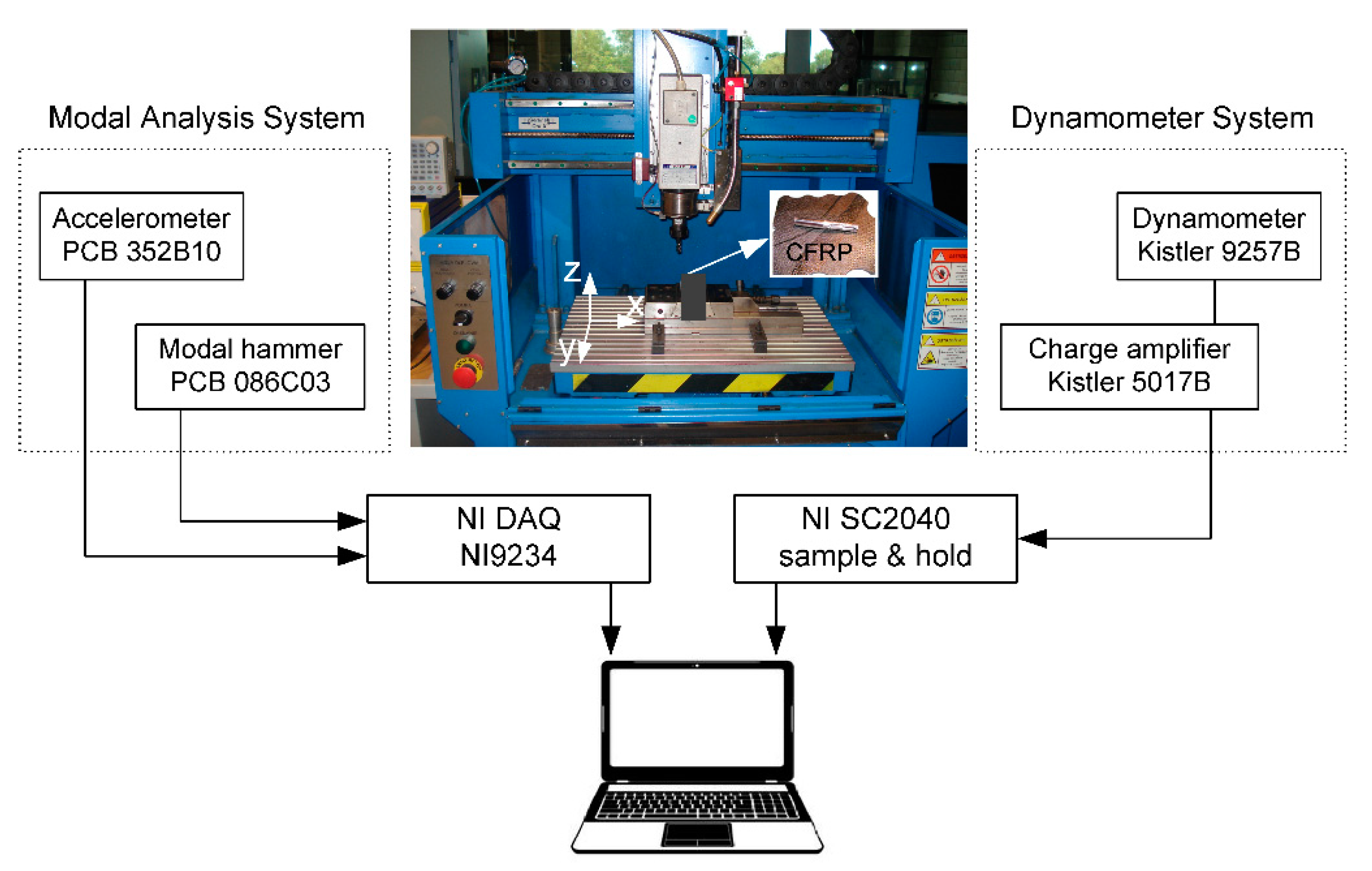
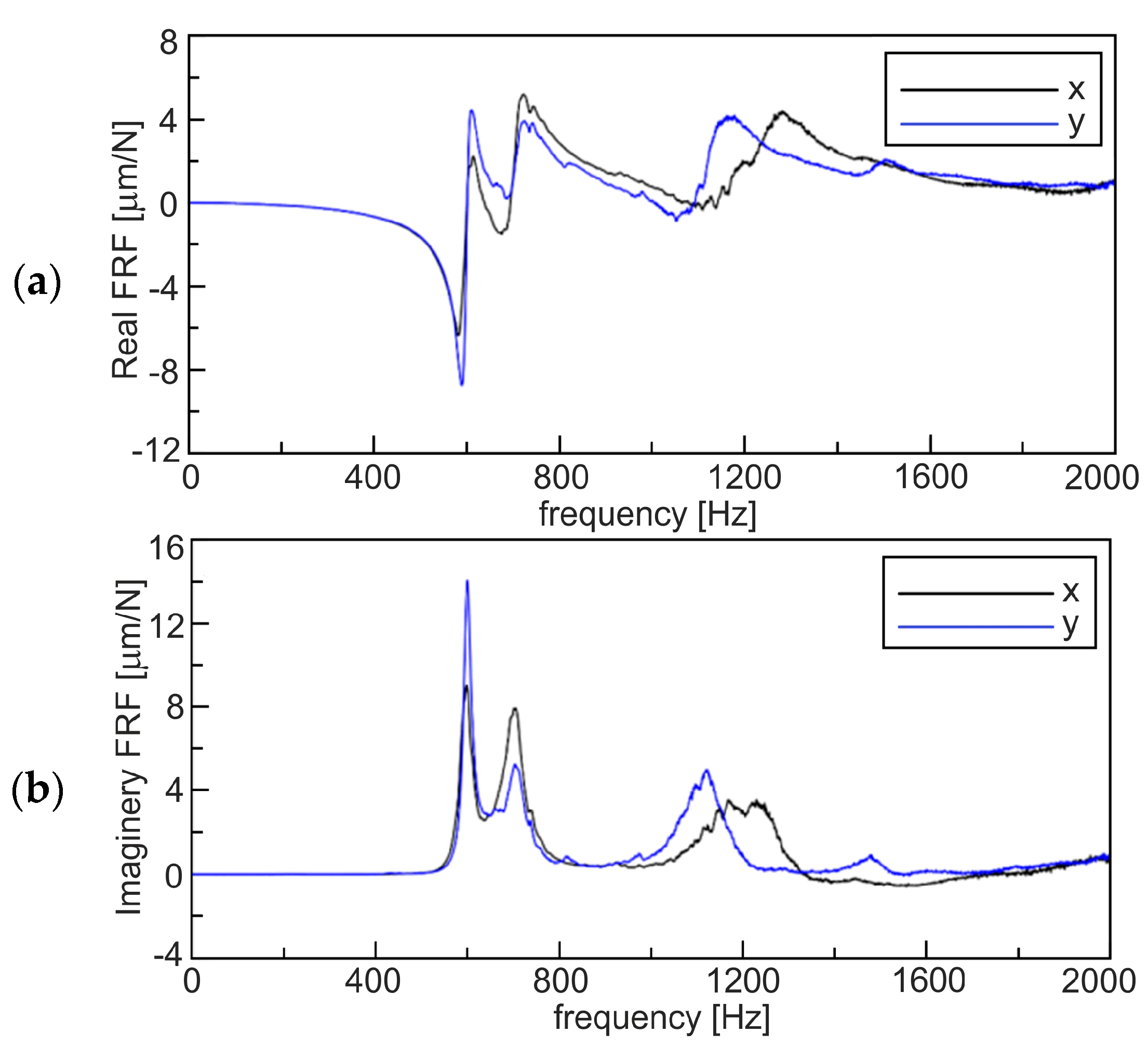
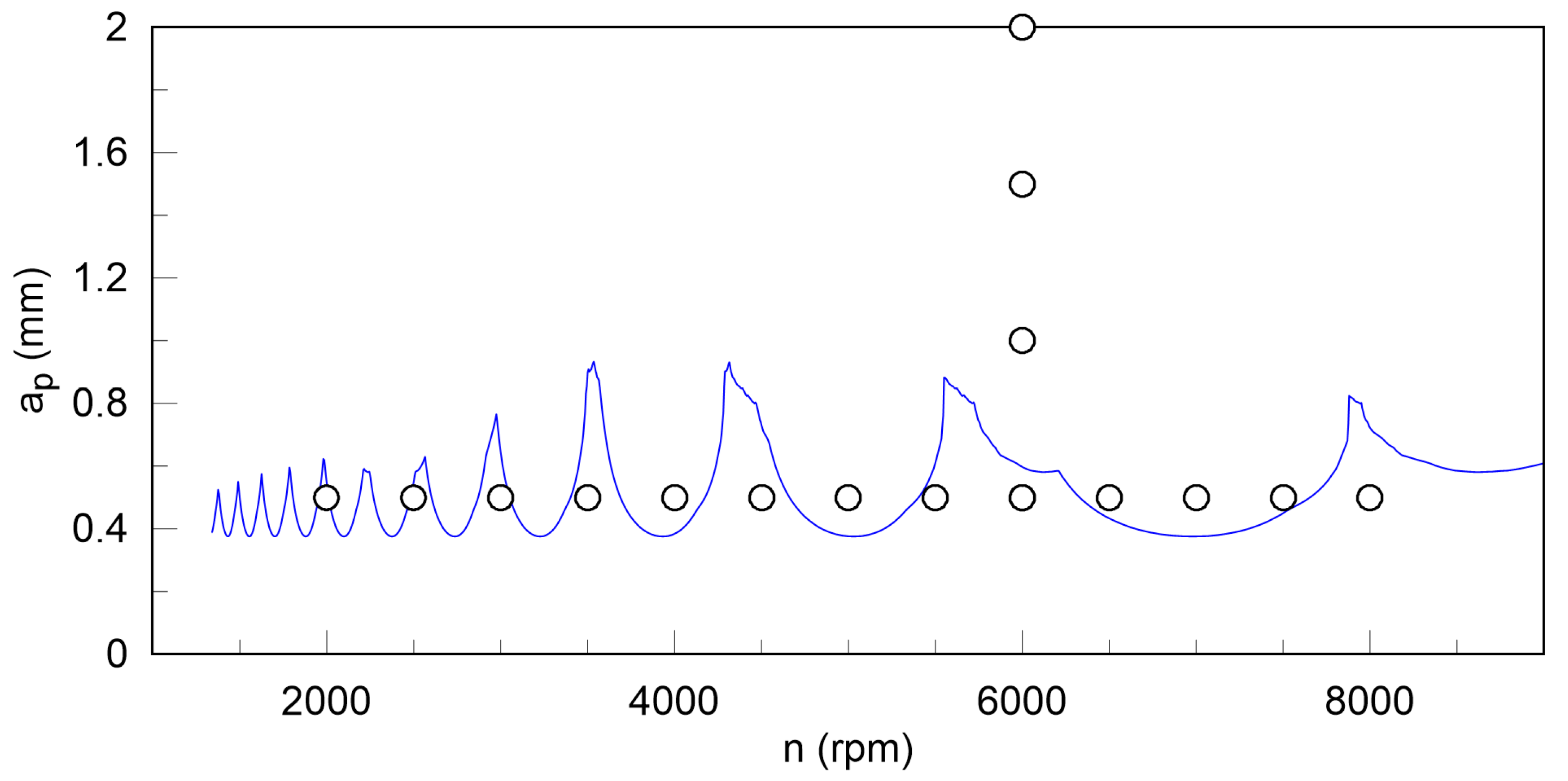
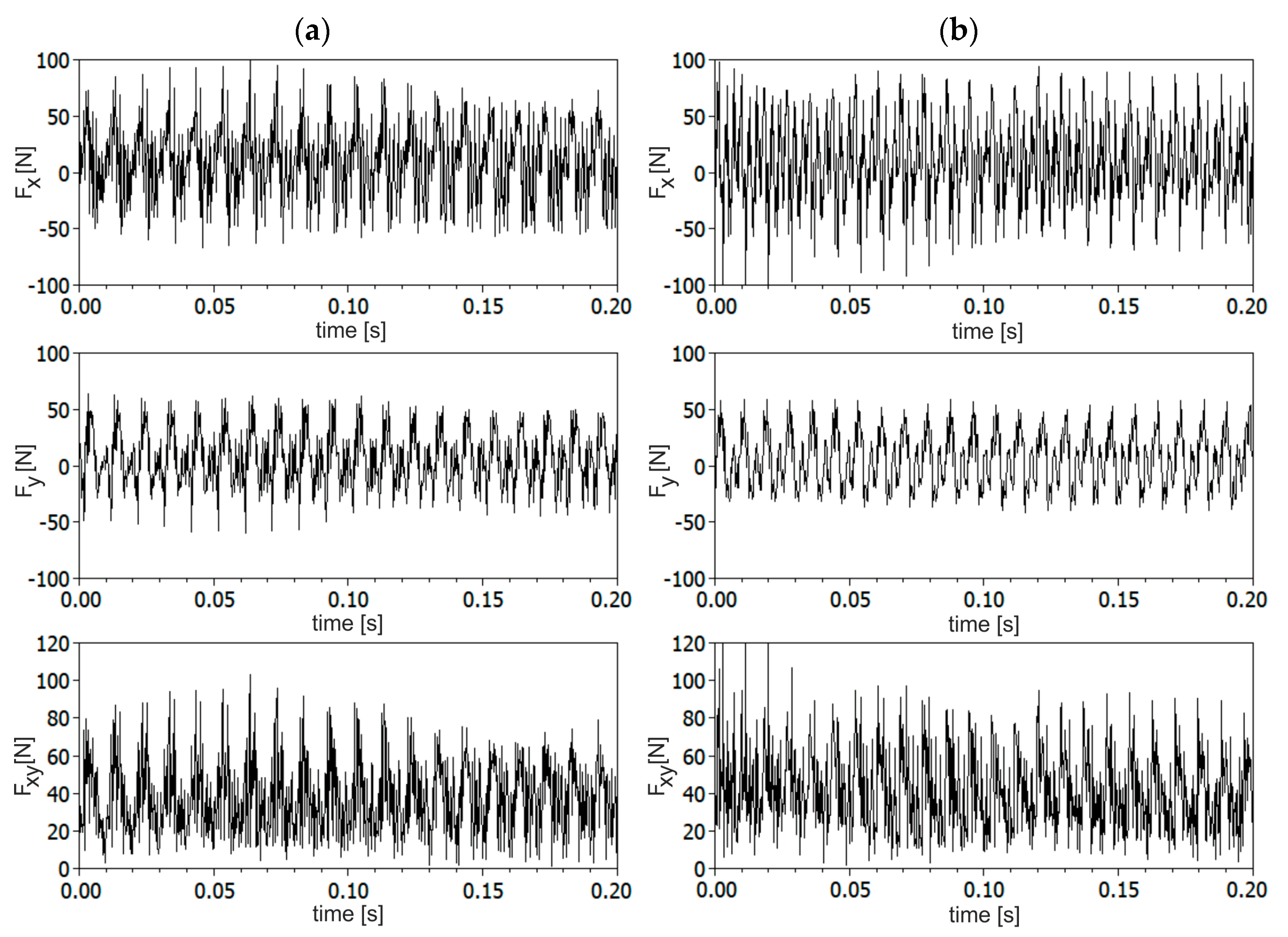
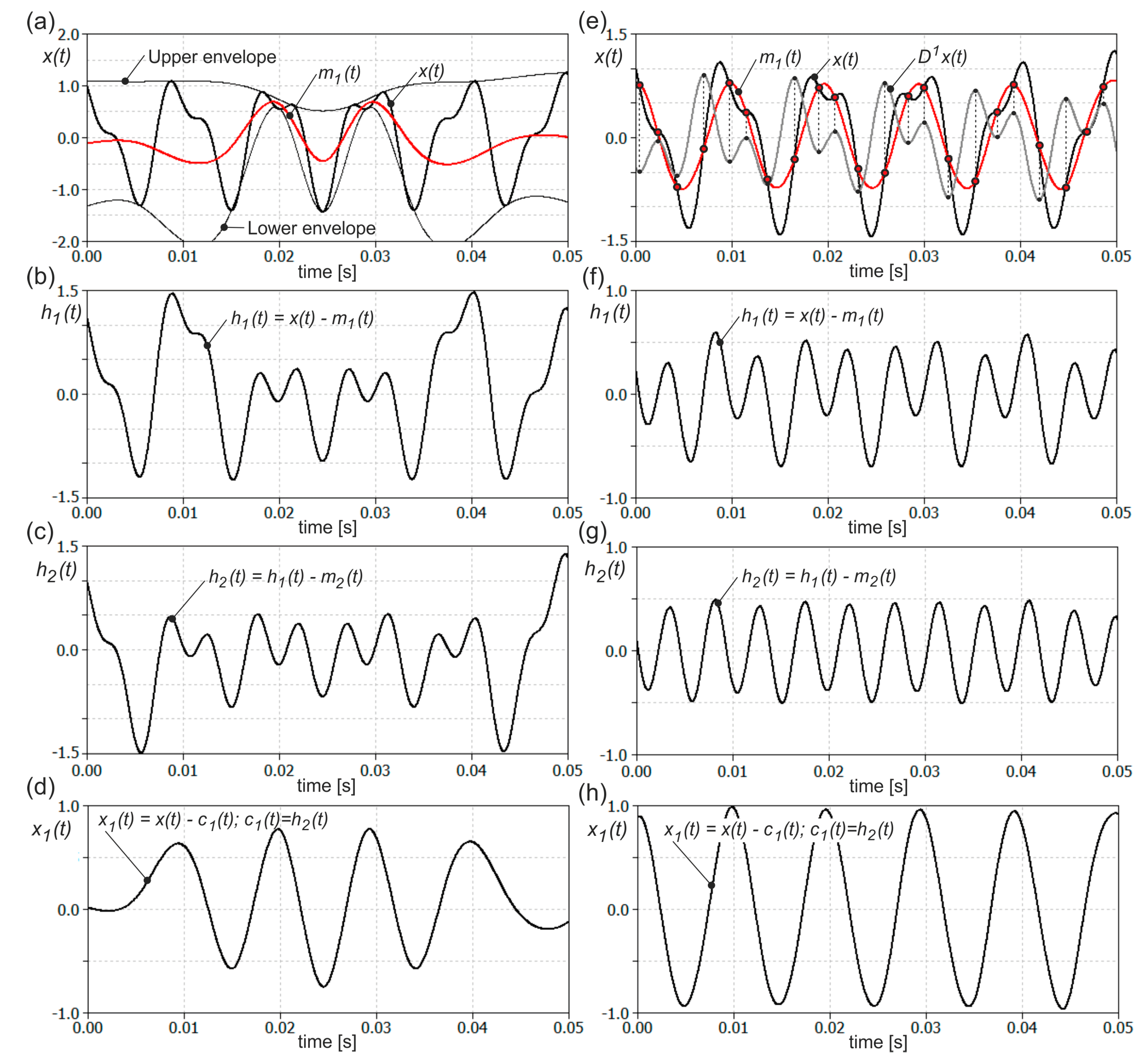
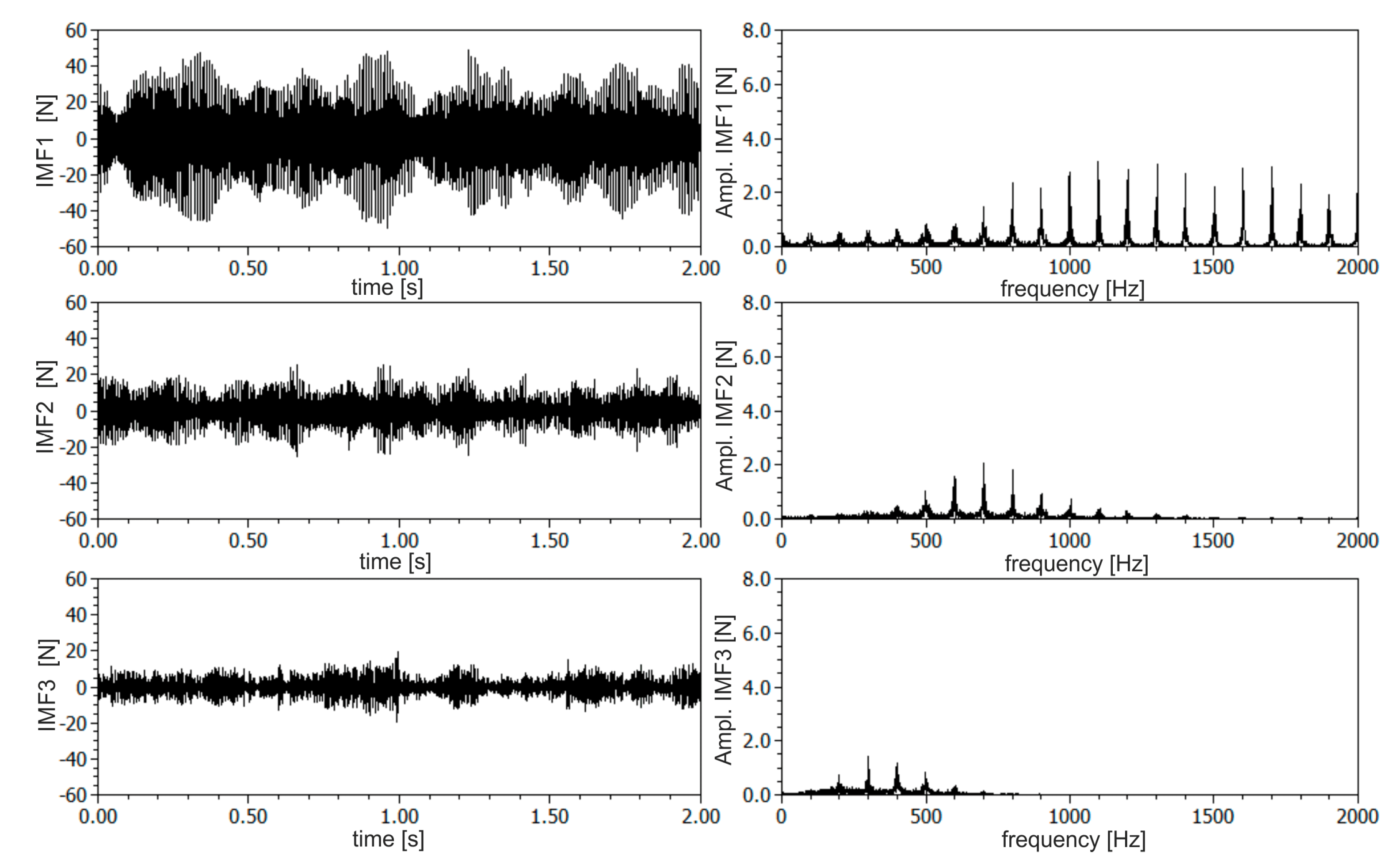
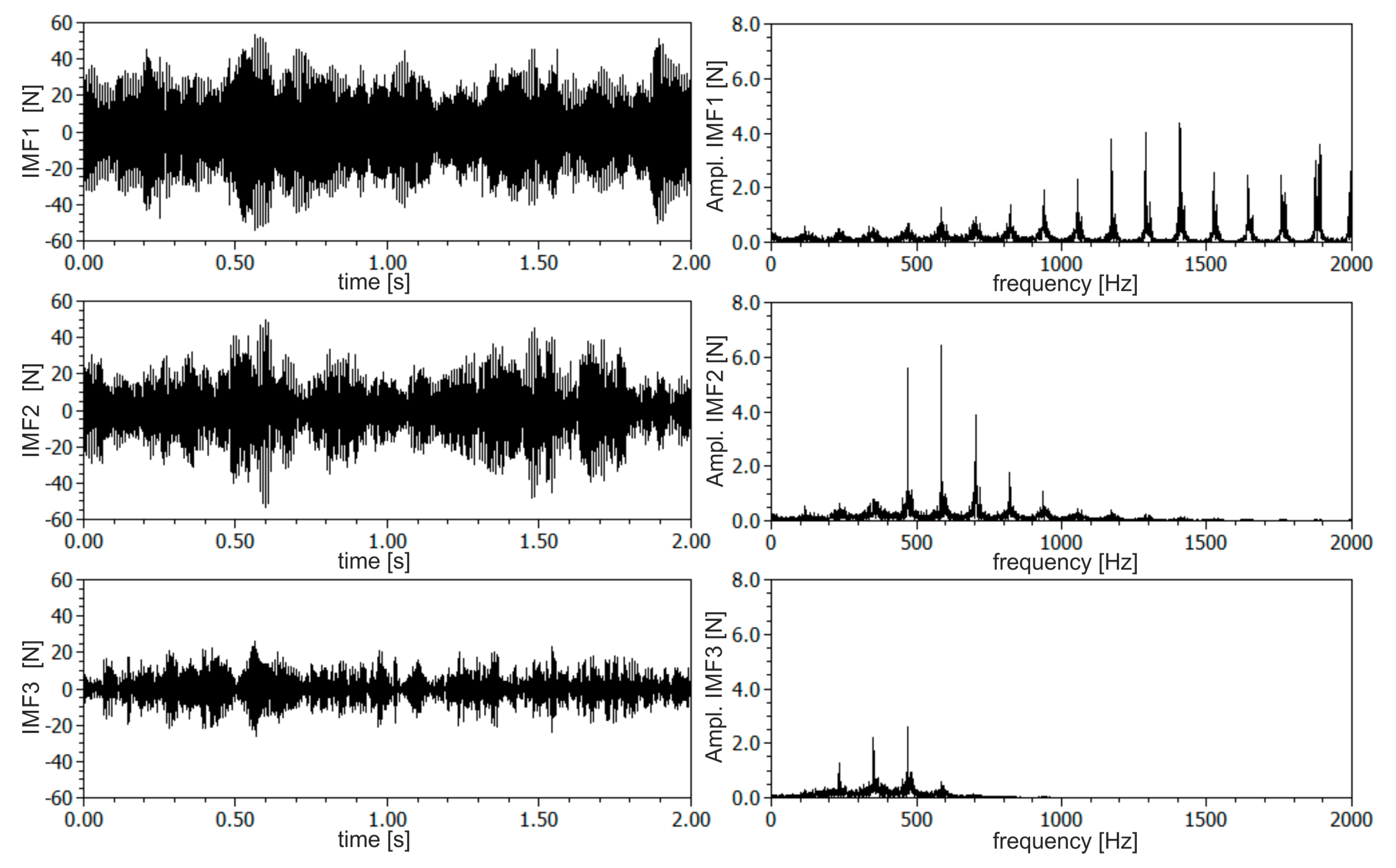
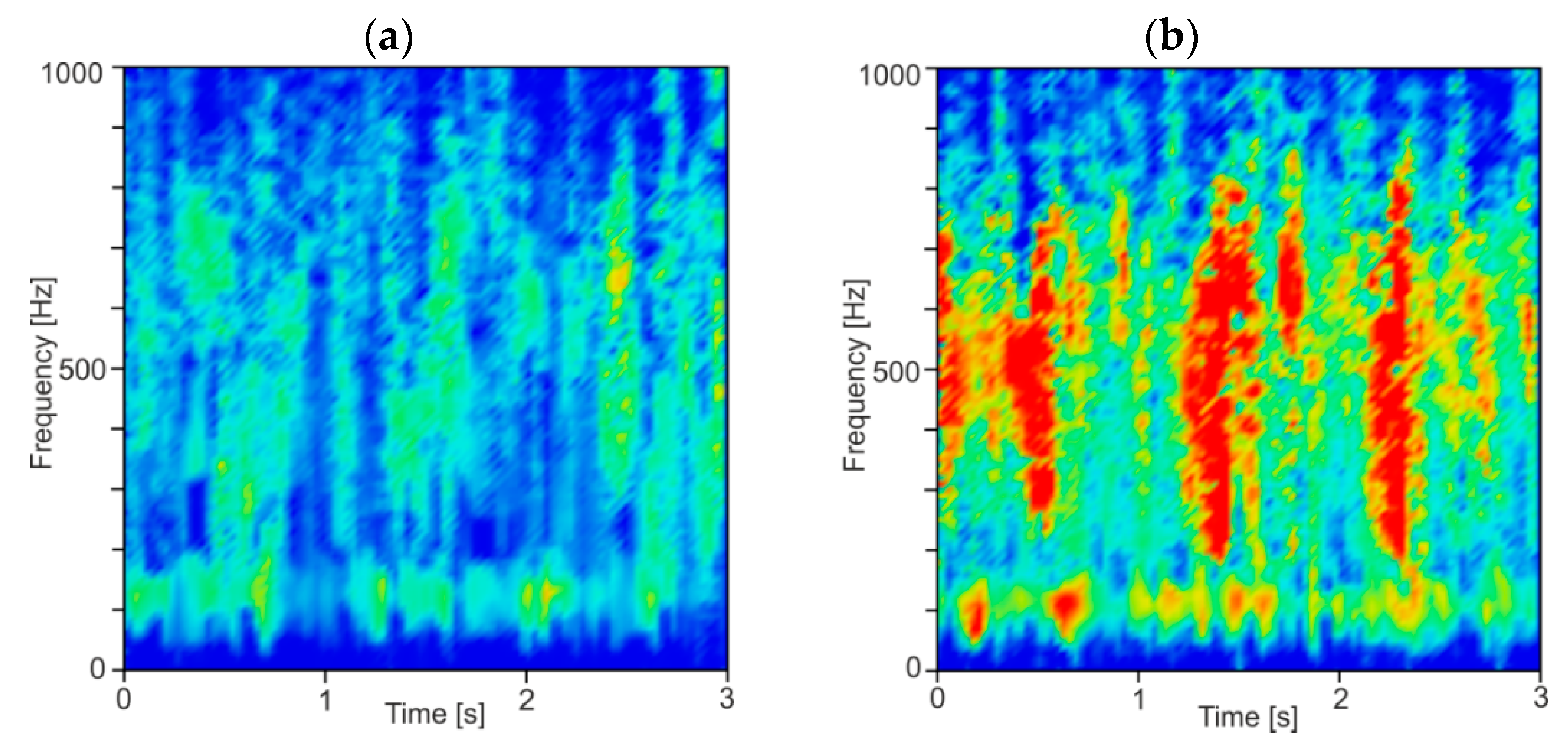
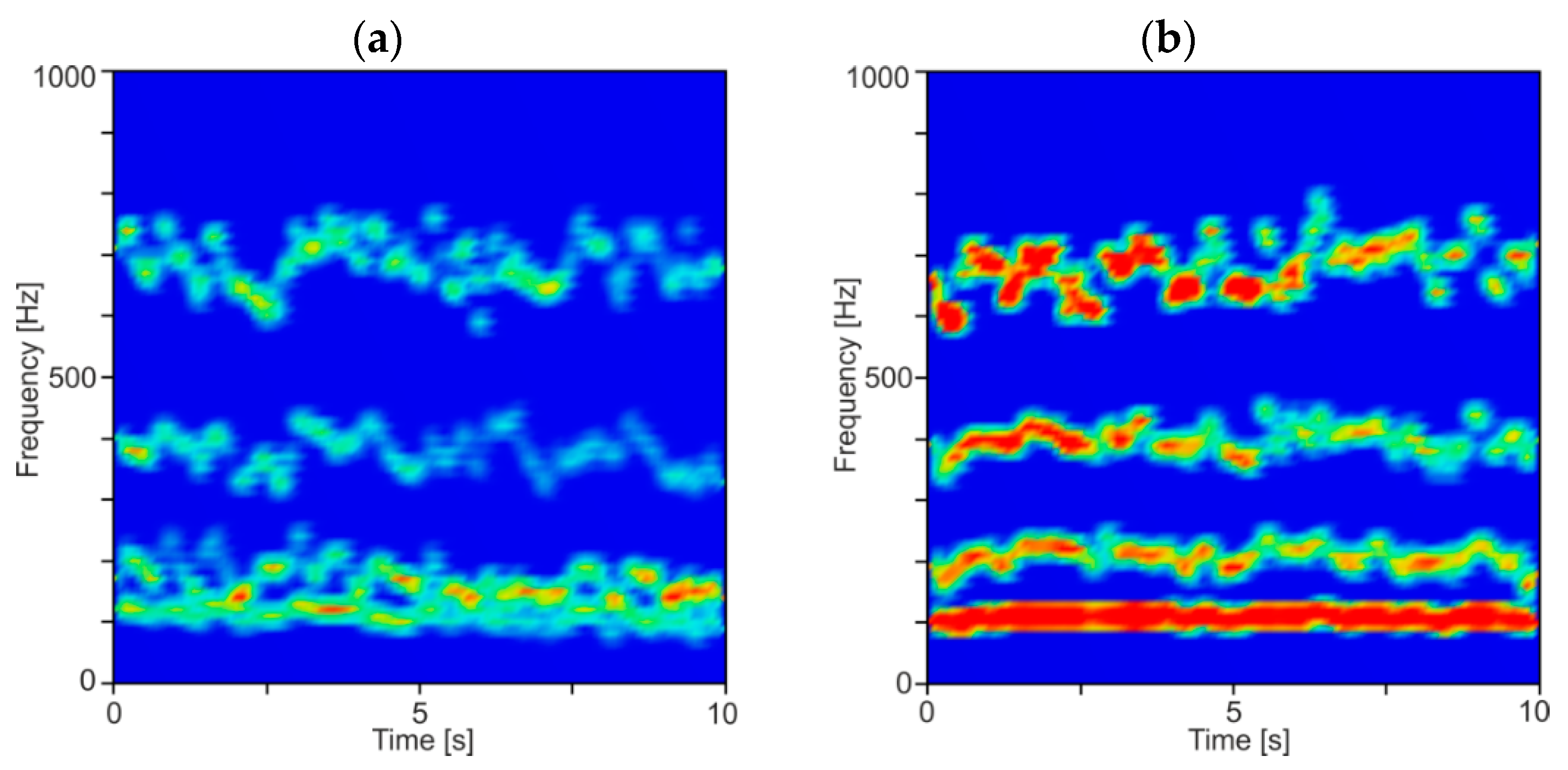
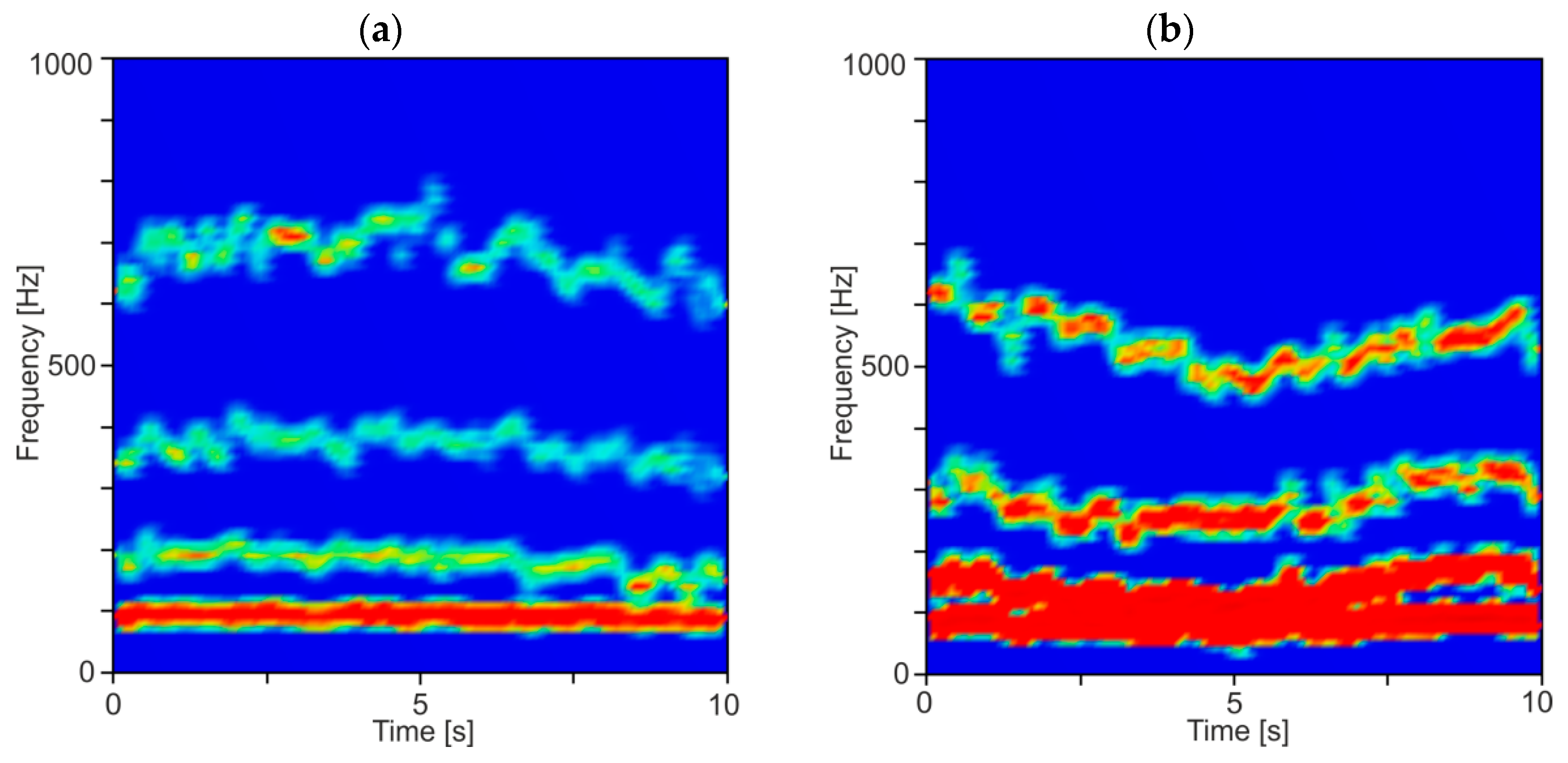
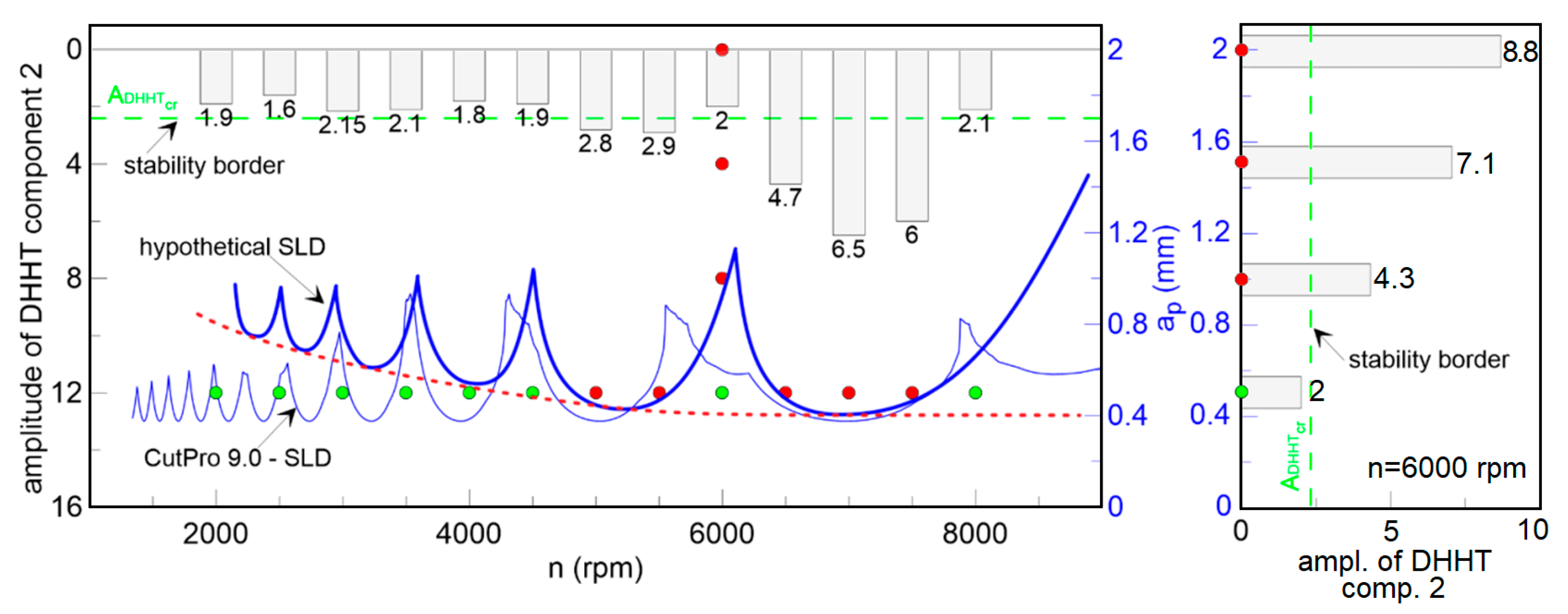
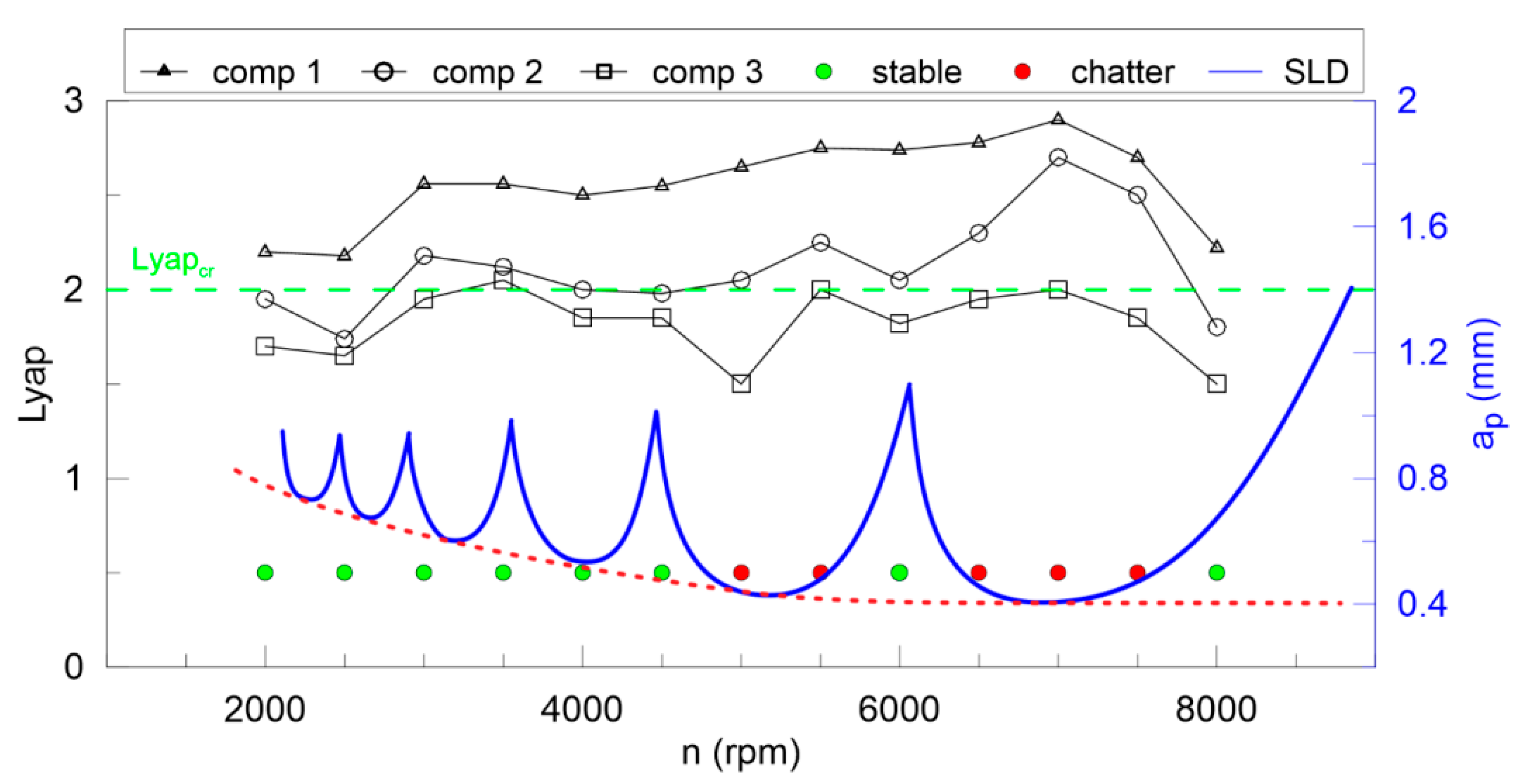
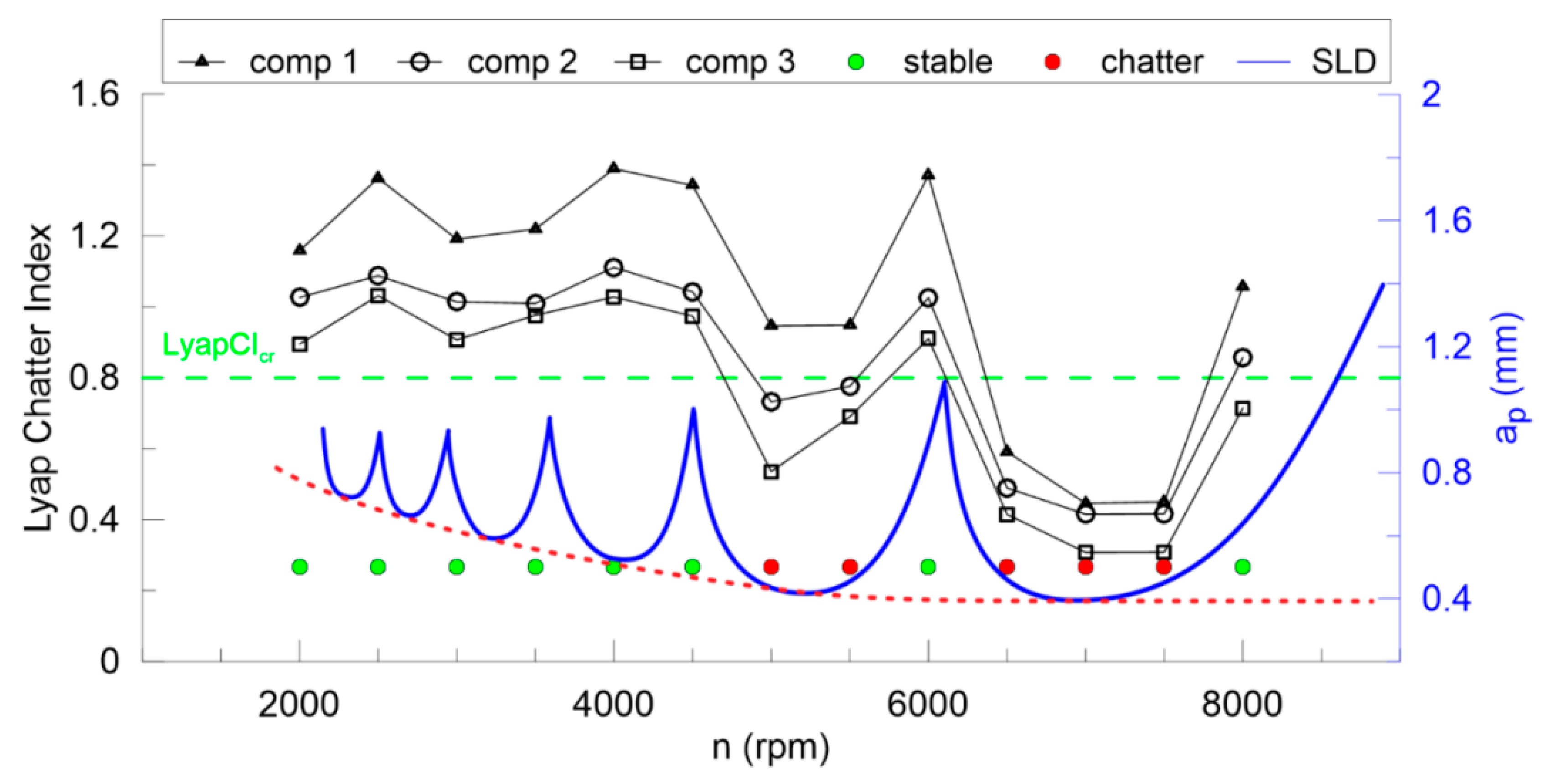
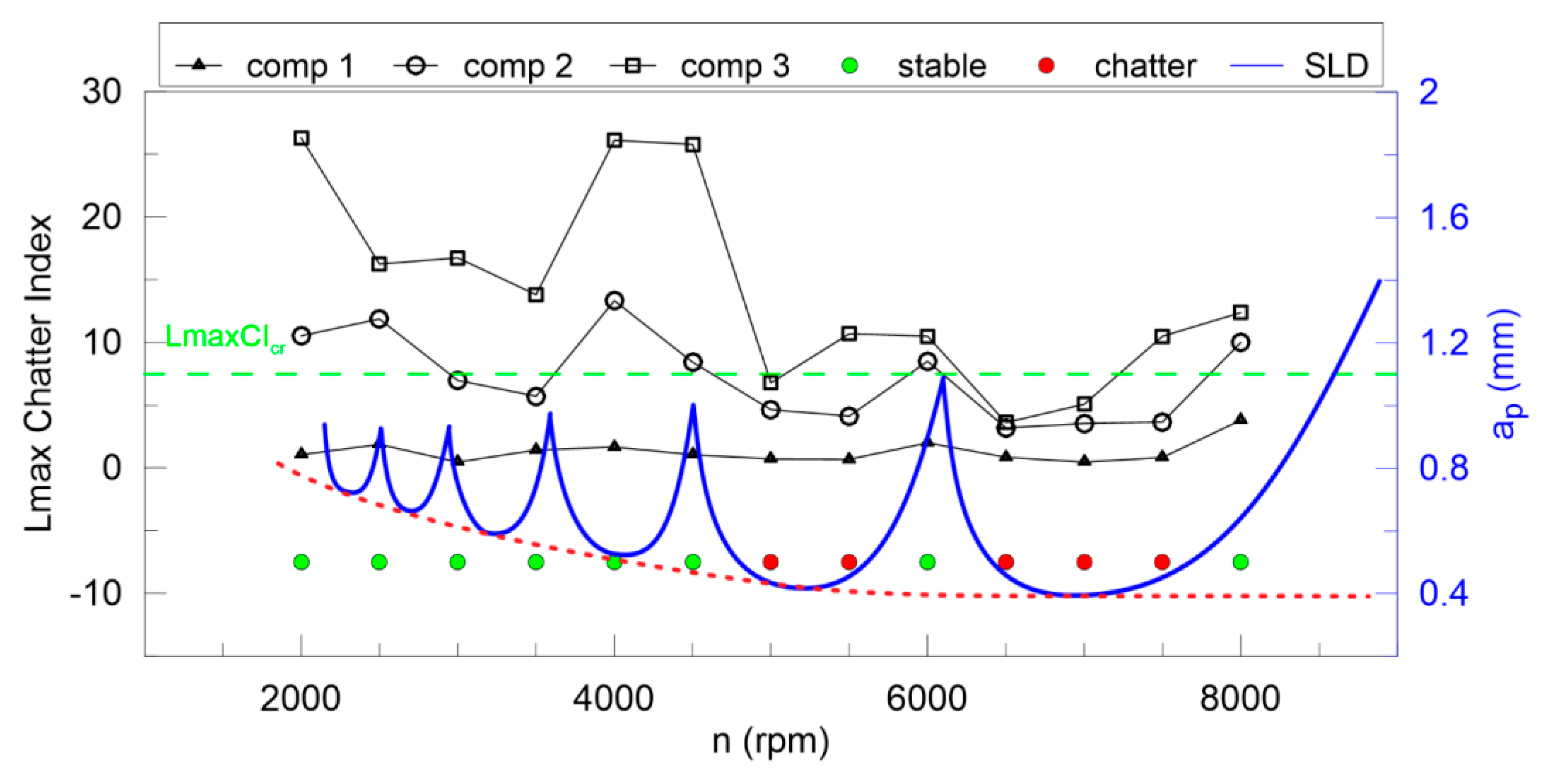




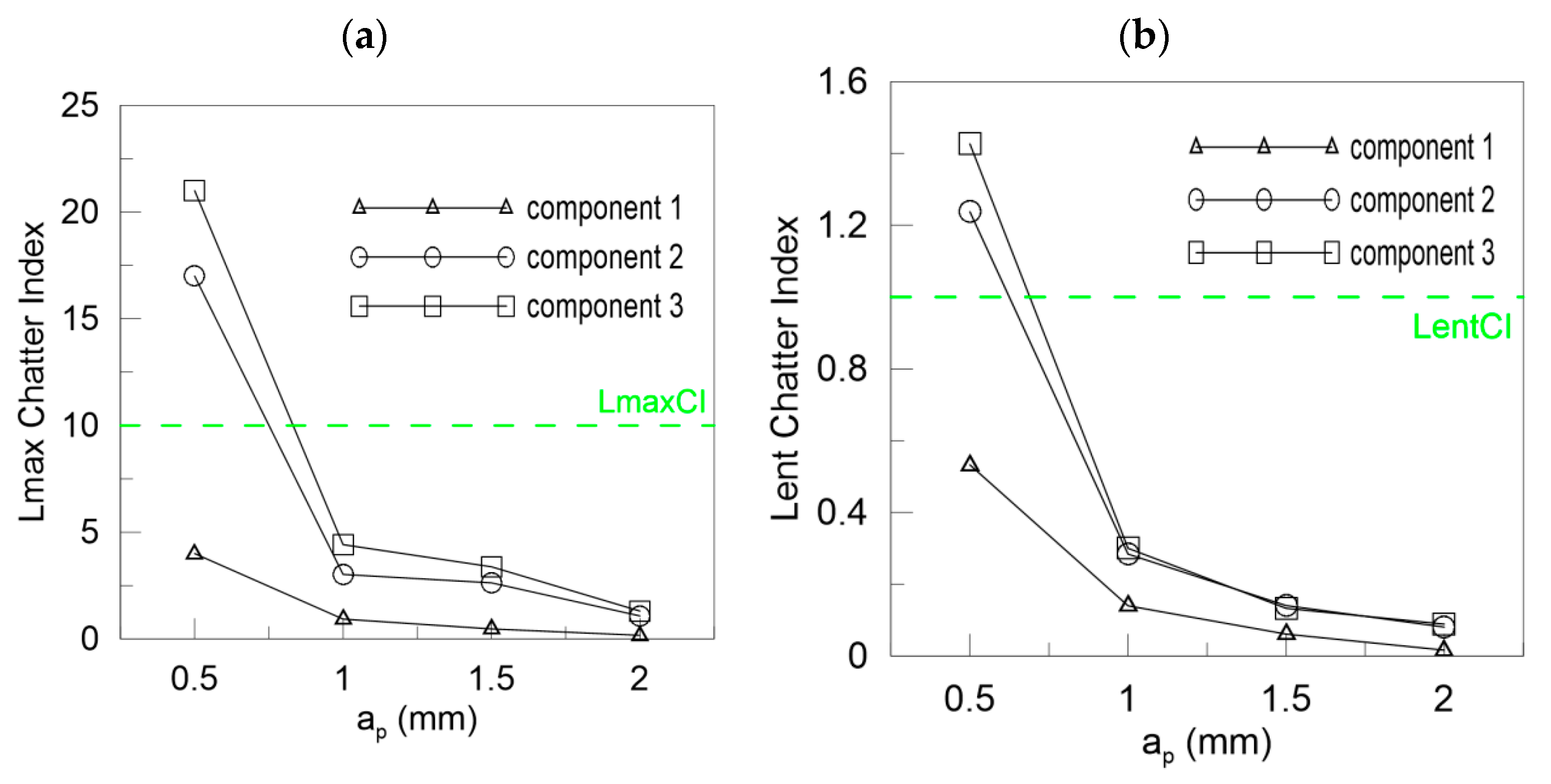

| Test of rational speed (constant ap): ae = 12 mm, fz = 0.05 mm/flute, ap = 0.5 mm | |||||||||||||
| n | 2000 | 2500 | 3000 | 3500 | 4000 | 4500 | 5000 | 5500 | 6000 | 6500 | 7000 | 7500 | 8000 |
| (rpm) | |||||||||||||
| Test of cutting depth (constant n): ae = 12 mm, fz = 0.05 mm/flute, n = 6000 rpm | |||||||||||||
| ap | 0.5 | 1.0 | 1.5 | 2.0 | |||||||||
| (mm) | |||||||||||||
© 2020 by the authors. Licensee MDPI, Basel, Switzerland. This article is an open access article distributed under the terms and conditions of the Creative Commons Attribution (CC BY) license (http://creativecommons.org/licenses/by/4.0/).
Share and Cite
Rusinek, R.; Lajmert, P. Chatter Detection in Milling of Carbon Fiber-Reinforced Composites by Improved Hilbert–Huang Transform and Recurrence Quantification Analysis. Materials 2020, 13, 4105. https://doi.org/10.3390/ma13184105
Rusinek R, Lajmert P. Chatter Detection in Milling of Carbon Fiber-Reinforced Composites by Improved Hilbert–Huang Transform and Recurrence Quantification Analysis. Materials. 2020; 13(18):4105. https://doi.org/10.3390/ma13184105
Chicago/Turabian StyleRusinek, Rafał, and Paweł Lajmert. 2020. "Chatter Detection in Milling of Carbon Fiber-Reinforced Composites by Improved Hilbert–Huang Transform and Recurrence Quantification Analysis" Materials 13, no. 18: 4105. https://doi.org/10.3390/ma13184105
APA StyleRusinek, R., & Lajmert, P. (2020). Chatter Detection in Milling of Carbon Fiber-Reinforced Composites by Improved Hilbert–Huang Transform and Recurrence Quantification Analysis. Materials, 13(18), 4105. https://doi.org/10.3390/ma13184105






